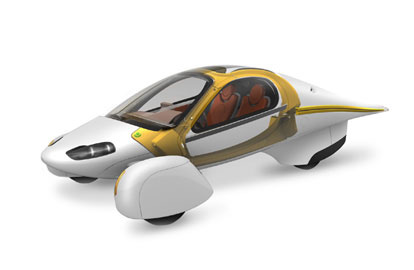Real Electric Car Featured in Star Trek Movie

The Aptera electric car is so futuristic-looking, it's been seen on the set of the new Star Trek movie.
The Aptera was designed from the ground up as an electric vehicle, and later as an extended range electric vehicle. After building the proof-of-concept Mk-0, [they] hired the automotive design firm, 'eleven', to help further develop the concept vehicle. The 'eleven' team ... made great strides in the development of the Aptera's body styling, interior design, and structural engineering. [They] refined the Aptera's shape to maximize efficiency using Computational Fluid Dynamics, developed and built advanced suspension and drivetrain components, and integrated a strong yet lightweight composite shell.
The Aptera is a unique 3-wheel, multiple-passenger vehicle with a composite safety cage (like those in Formula 1 cars); the two wheels in the front, one in the back, design reduces roll-over. The car has traction control and the production models will be able to exceed 85 miles per hour. The price? About $26,000.
The new Star Trek will tell the story of the young James T. Kirk and his companions at Star Fleet Academy. Apparently, they will be tooling around the campus on the ghostly silent Aptera electric vehicle (see photo).
In his prophetic 1894 story A Journey in Other Worlds, John Jacob Astor referred to amazing vehicles that would silently carry passengers to their destination. All that was required was a source of power:
Another change that came in with a rush upon the discovery of a battery with insignificant weight, compact form, and great capacity, was the substitution of electricity for animal power for the movement of all vehicles. This, of necessity brought in good roads, the results obtainable on such being so much greater than on bad ones that a universal demand for them arose. This was in a sense cumulative, since the better the streets and roads became, the greater the inducement to have an electric carriage. (Read more about John Jacob Astor's electric phaetons)
See an Aptera video; story via Star Fleet Academy and Aptera.
(This Science Fiction in the News story used with permission of Technovelgy.com - where science meets fiction)
Sign up for the Live Science daily newsletter now
Get the world’s most fascinating discoveries delivered straight to your inbox.









